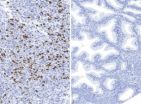(Press-News.org) LOS ALAMOS, N.M., March 15, 2013 — Members of the Mars Science Laboratory Curiosity rover ChemCam team will present more than two dozen posters and talks next week during the 44th Lunar and Planetary Science Conference in The Woodlands, Texas.
"ChemCam has performed flawlessly in its first six months, providing more than a gigabyte of exciting new information about the Red Planet," said Los Alamos National Laboratory planetary scientist Roger Wiens, Principal Investigator of the ChemCam Team. "Since Curiosity's successful landing on Mars on August 6, 2012, ChemCam has fired more than 40,000 shots at more than a thousand different locations with its high-powered laser. Each of those shots has yielded exciting information about the Martian habitat, and our team has been extremely busy making sense of what we're seeing in anticipation of presenting it to planetary scientists and the public. The Curiosity mission continues to amaze us with new discoveries, finding Mars to be very Earth-like in many ways."
The ChemCam team's work will be showcased during a series of special sessions at the conference on Monday and during a blitz of poster sessions on Tuesday. The international team of researchers will provide everything from a geological tour of the Martian landscape during the first six months of the SUV-sized rover's cross-country journey, to investigations of the dusty coating that covers every Martian rock, to a discussion of how scientists used calibration targets mounted on the rover to fine tune differences between spectral readings taken on Earth and on Mars.
ChemCam team member Nina Lanza was selected by conference organizers to chronicle her experiences as a presenter and a conference attendee through microblogging activities all week. Lanza will provide commentary and highlights of each day's events through her Twitter feed (@marsninja).
The ChemCam system is one of 10 instruments mounted on the Curiosity rover—a six-wheeled mobile laboratory that will roam more than 12 miles of the planet's surface during the course of one Martian year (98 Earth weeks). ChemCam can fire an extremely powerful laser pulse up to 23 feet onto an area the size of a pinhead. The laser vaporizes a tiny portion of the target. A spectrometer then translates the spectral colors of the plasma into the chemical composition of the vaporized material.
###
The ChemCam team is comprised of researchers from Los Alamos National Laboratory and the French space agency, Centre National d'Etudes Spatiales, as well as other researchers from the U.S., France, Canada, and the United Kingdom. ChemCam operations are now commanded from centers at Los Alamos and Toulouse, France.
The 44th Lunar and Planetary Science Conference runs from March 18-22. The conference webpage is http://www.lpi.usra.edu/meetings/lpsc2013/
About Los Alamos National Laboratory
Los Alamos National Laboratory, a multidisciplinary research institution engaged in strategic science on behalf of national security, is operated by Los Alamos National Security, LLC, a team composed of Bechtel National, the University of California, The Babcock & Wilcox Company and URS for the Department of Energy's National Nuclear Security Administration.
Los Alamos enhances national security by ensuring the safety and reliability of the U.S. nuclear stockpile, developing technologies to reduce threats from weapons of mass destruction, and solving problems related to energy, environment, infrastructure, health and global security concerns.
ChemCam data abundant at Planetary Conference
Laser instrument aboard Curiosity rover provides well over 40,000 shots so far
2013-03-18
ELSE PRESS RELEASES FROM THIS DATE:
UK study: Epigenetic changes play a key role in development of chemo resistance in BCa
2013-03-18
Milan, 16 March 2013 - At the 28th Annual EAU Congress currently ongoing in Milan until Tuesday, W. Tan and colleagues presented their study on neoadjuvant cisplatin-based chemotherapy which showed that epigenetic changes are potential key drivers in the development of chemo resistance in bladder cancer.
Neoadjuvant cisplatin-based chemotherapy is recommended for patients with muscle invasive bladder cancer. Cisplatin-based regimes have similar efficacy with complete response in 30% a survival advantage if 16% (HR, 0.84;CI 0.72 to 0.99), wrote Tan of the UCL, Dept. ...
New study points to the aggressive potential of small kidney tumors, advocates treatment
2013-03-18
Milan, 16 March 2013 – Small kidney tumours have an agressive potential and should be treated, according to a the results of a large multicentre study presented at the 28th Annual EAU Congress in Milan.
"Many clinicians regard small renal cell cancer as having a benign biologic behavior and non-operative surveillance protocols are often being used in patients with small renal tumours," write the authors in the findings. "The aim of this large retrospective multi-centre study was to evaluate the prevalence of locally advanced growth and distant metastases in patients with ...
Where, oh where, has the road kill gone?
2013-03-18
Millions of birds die in the US each year as they collide with moving vehicles, but things have been looking up, at least in the case of cliff swallows. Today's swallows are hit less often, thanks to shorter wingspans that may help them take off more quickly and pivot away from passing cars. The findings, reported in the Cell Press journal Current Biology on March 18, show that urban environments can be evolutionary hotspots.
"Evolution is an ongoing process, and all this—roads, SUVs, and all—is part of nature or 'the wild'; they exert selection pressures in a way we ...
Putting the clock in 'cock-a-doodle-doo'
2013-03-18
Of course, roosters crow with the dawn. But are they simply reacting to the environment, or do they really know what time of day it is? Researchers reporting on March 18 in Current Biology, a Cell Press publication, have evidence that puts the clock in "cock-a-doodle-doo" (or "ko-ke-kok-koh," as they say in the research team's native Japan).
"'Cock-a-doodle-doo' symbolizes the break of dawn in many countries," says Takashi Yoshimura of Nagoya University. "But it wasn't clear whether crowing is under the control of a biological clock or is simply a response to external ...
How some prostate tumors resist treatment -- and how it might be fixed
2013-03-18
LA JOLLA, Calif., March 18, 2013 – Hormonal therapies can help control advanced prostate cancer for a time. However, for most men, at some point their prostate cancer eventually stops responding to further hormonal treatment. This stage of the disease is called androgen-insensitive or castration-resistant prostate cancer. In a study published March 18 in Cancer Cell, a team led by researchers at Sanford-Burnham Medical Research Institute (Sanford-Burnham) found a mechanism at play in androgen-insensitive cells that enables them to survive treatment. They discovered that ...
Oral estrogen hormone therapy linked to increased risk of gallbladder surgery in menopausal women
2013-03-18
Oral estrogen therapy for menopausal women is associated with an increased risk of gallbladder surgery, according to a large-scale study of more than 70 000 women in France published in CMAJ (Canadian Medical Association Journal)
Women who took estrogen therapy through skin patches or gels did not appear to be at increased risk.
Gallstone disease is common in developed countries, and women over age 50 are most at risk. Other risk factors include obesity, diabetes, high cholesterol, poor diet and having given birth to two or more children.
A large study of 70 928 ...
Blood protein able to detect higher risk of cardiovascular events
2013-03-18
Higher levels of pregnancy-associated plasma protein A (PAPP-A) were associated with an increased risk of cardiovascular events in people with cardiac chest pain that developed as a result of heart disease/coronary artery disease, according to a study published in CMAJ.
PAPP-A, used to screen for Down syndrome in pregnant women, has been suggested as a marker of unstable plaque in coronary arteries.
The study was conducted in 2568 patients in Tübingen, Germany, to determine if the presence of PAPP-A could help predict cardiovascular events. The study included patients ...
Training program developed by U of A medical researchers leads to police using less force
2013-03-18
Researchers with the Faculty of Medicine & Dentistry designed a one-day training program for the Edmonton Police Service that resulted in officers being more likely to quickly identify mental health issues during a call, and less likely to use physical force or a weapon in those situations. The training resulted in long-term behaviour change in the officers and saved the police force money because mental health-related calls were dealt with more efficiently.
The pilot study published in the open access and peer-reviewed journal, Frontiers in Psychiatry, noted the following ...
Researchers trap light, improve laser potential of MEH-PPV polymer
2013-03-18
Researchers from North Carolina State University have come up with a low-cost way to enhance a polymer called MEH-PPV's ability to confine light, advancing efforts to use the material to convert electricity into laser light for use in photonic devices.
"Think of a garden hose. If it has holes in it, water springs out through a million tiny leaks. But if you can eliminate those leaks, you confine the water in the hose and improve the water pressure. We've plugged the holes that were allowing light to leak out of the MEH-PPV," says Dr. Lewis Reynolds, a teaching associate ...
Astrocyte signaling sheds light on stroke research
2013-03-18
BOSTON (March 18, 2013) — New research published in The Journal of Neuroscience suggests that modifying signals sent by astrocytes, our star-shaped brain cells, may help to limit the spread of damage after an ischemic brain stroke. The study in mice, by neuroscientists at Tufts University School of Medicine, determined that astrocytes play a critical role in the spread of damage following stroke.
The National Heart Foundation reports that ischemic strokes account for 87% of strokes in the United States. Ischemic strokes are caused by a blood clot that forms and travels ...
LAST 30 PRESS RELEASES:
Numbers in our sights affect how we perceive space
SIMJ announces global collaborative book project in commemoration of its 75th anniversary
Air pollution exposure and birth weight
Obstructive sleep apnea risk and mental health conditions among older adults
How talking slows eye movements behind the wheel
The Ceramic Society of Japan’s Oxoate Ceramics Research Association launches new international book project
Heart-brain connection: international study reveals the role of the vagus nerve in keeping the heart young
Researchers identify Rb1 as a predictive biomarker for a new therapeutic strategy in some breast cancers
Survey reveals ethical gaps slowing AI adoption in pediatric surgery
Stimulant ADHD medications work differently than thought
AI overestimates how smart people are, according to HSE economists
HSE researchers create genome-wide map of quadruplexes
Scientists boost cell "powerhouses" to burn more calories
Automatic label checking: The missing step in making reliable medical AI
Low daily alcohol intake linked to 50% heightened mouth cancer risk in India
American Meteorological Society announces Rick Spinrad as 2026 President-Elect
Biomass-based carbon capture spotlighted in newly released global climate webinar recording
Illuminating invisible nano pollutants: advanced bioimaging tracks the full journey of emerging nanoscale contaminants in living systems
How does age affect recovery from spinal cord injury?
Novel AI tool offers prognosis for patients with head and neck cancer
Fathers’ microplastic exposure tied to their children’s metabolic problems
Research validates laboratory model for studying high-grade serous ovarian cancer
SIR 2026 delivers transformative breakthroughs in minimally invasive medicine to improve patient care
Stem Cell Reports most downloaded papers of 2025 highlight the breadth and impact of stem cell research
Oxford-led study estimates NHS spends around 3% of its primary and secondary care budget on the health impacts of heat and cold in England
A researcher’s long quest leads to a smart composite breakthrough
Urban wild bees act as “microbial sensors” of city health.
New study finds where you live affects recovery after a hip fracture
Forecasting the impact of fully automated vehicle adoption on US road traffic injuries
Alcohol-related hospitalizations from 2016 to 2022
[Press-News.org] ChemCam data abundant at Planetary ConferenceLaser instrument aboard Curiosity rover provides well over 40,000 shots so far


